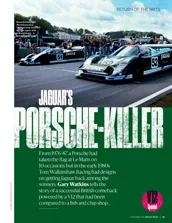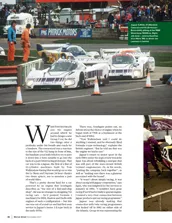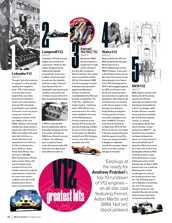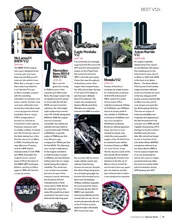In Jaguar’s favour lay the fuel efficiency of its naturally aspirated 7-litre V12, the inherently better ground-effect achieved with a vee rather than a flat-formation engine, its carbon tub and more modern design. Stacked against it was the fact that, for all its 750bhp, the V12 was derived from a road car engine, and in length, height and weight far from ideal for Group C racing. Watson describes it as “a land anchor in the back of the car”.
What it boiled down to were two cars that, lap for lap, hour after hour, were incredibly closely matched. “It was fascinating to watch their relative performance,” remembers Wallace. “The Porsche had more power; we had less drag. You’d come out of Tertre Rouge with a 962 on your tail, hammer down the straight and it would pull out and come past. We’d wave and I’d tuck into the slipstream. And near the end of the straight I’d pop out and repass the Porsche. That happened lap after lap.”
The event that decided the race came after only four hours. I was in the crowd above the old pits. I remember well the cheer as the 962 came chugging into the pit-lane, Ludwig at the wheel, drive delivered by nothing more powerful than its starter motor. Stories conflict as to why the car ran out of fuel. In its original race report, this magazine stated that “the reserve fuel pump failed to work properly’” but team boss Norbert Singer blamed the error on “Ludwig’s mistake of running out of fuel.” Derek Bell is equally clear on the subject: “The reserve? Well, it worked perfectly well for the rest of the race…”

962s rocket off the start with “explosive” acceleration
Getty Images
Whatever the truth, the 962 lost nearly two laps. Watching it claw them back was agonising. None of the Brits in the crowd wanted a Porsche to win at Jaguar’s expense. On the other we’d have loved to have seen Derek equal Ickx’s then-record six wins. Watching the effort was spellbinding.
And, for a while, it looked as if it might do it. The Wallace/Lammers/Dumfries Jaguar had led from shortly after midnight, but as morning turned to afternoon, so sunshine turned to rain. Suddenly the Porsche, hitherto hobbled by its need to watch its fuel consumption, was released. Watching Stuck in the wet, Stuck on the grass, Stuck carving huge chunks out of the lead, will live forever in the hearts of all who saw it. Had it stayed wet, he might even have done it.
But it didn’t and with half an hour to go, the next chapter in the history of Jaguar winning Le Mans, 31 years in the creation, seemed all but written. And then its gearbox mainshaft broke. “Jan was driving at the time,” Wallace recalls. “He was the best team-mate you could have. Before the race he’d told Johnny and me to stay a gear up through the Esses and Porsche Curves as it would save us something like 1500 gearchanges through the race. There was no telemetry in those days so he could easily have said it to make himself look quicker than us, but not Jan. We trusted him, did as he suggested, and had we not I have no doubt Jaguar would not have won Le Mans.”
Over in the Porsche pit, it looked simply like Jaguar slowed to save the car. “In fact Jan had fourth and fifth gears, and it was only third gear that was holding the shaft together,” says Wallace. “We weren’t going to tell them that.” As they started the 394th and last lap just 100sec separated the red and yellow Porsche from the white and purple Jaguar; or, put another way, an advantage in Jaguar’s favour of just 0.25sec per lap over the course of the race.

Porsches chase the Jag
Getty Images
The record books show that the Porsche lost nearly a minute in that last lap, finishing 2min 37sec behind the Jaguar. What the record books don’t show is that by the time the Porsche reached the home straight, the track was so swamped with Jag fans it actually finished in the pit-lane.
If Bell was cheesed off, he fails to display it today: “It was one of the great races. However much you curse your luck, another part of you relishes the challenge. We gave it everything for 20 hours and got damn close. And there was the consolation of seeing Jaguar win Le Mans.”
To Wallace it was something else again. “I was stunned by the whole occasion. The race, the car and the fans in particular made it an astonishing event. I will never forget being up there on the podium – the old podium – looking down at the sea of faces and flags.”
And then they went their separate ways. The Jaguar ended up in the Jaguar Daimler Heritage Trust collection. The Porsche did one Supercup race before being sold to an American collector. It stayed in the US until last year when Henry Pearman brought it back to Europe.












